NOT MANY people understand what it means to encounter rock on a building site, and what it can mean for someone who has this problem.
Finding large embedded rock on your property can have significant cost implications for your home building project.
There are two ways rock can affect costs on a building site: one is where you actually encounter rock, literally striking rock during the excavation phase.
The other is when the varying depth of rock causes additional pier costs.
This article deals with the former.
This Huet Street building site used some imported fill to shape the block because the the steeply falling site needed it despite the bulk of the home being on steel posts. Nevertheless, rock, resistant to normal excavation methods, was encountered in the relatively small amount of excavation required.
The benching* of the site has been completed, with the annoying exception of this critical area. The excavation has exposed rock at a depth of approximately 700-800mm; half-way to the target 1.4 metres excavation depth and only affecting a tiny portion of the overall building platform. Despite using a 5-tonne excavator with a rock-breaker, it proved impossible to remove this rock.
Now, A larger machine with a rock-breaker has to be brought in to complete the task. It will probably require four or five hours of solid pounding to rid the block of the rock and to complete the benching process properly.
This necessary but unexpected exercise will probably add around $1000 to the projected costs.
*Benching is the process of excavating and filling a sloping block to create a level surface on which to build. See our Glossary page for more design and build terms and their meaning.
[button_1 text=”Custom%20Home%20Design%20%26%20Build” text_size=”32″ text_color=”#000000″ text_bold=”Y” text_letter_spacing=”0″ subtext_panel=”Y” subtext=”Find%20out%20More%20…%20″ subtext_size=”15″ subtext_color=”#ffffff” subtext_letter_spacing=”0″ text_shadow_panel=”Y” text_shadow_vertical=”1″ text_shadow_horizontal=”0″ text_shadow_color=”#ffff00″ text_shadow_blur=”0″ styling_width=”12″ styling_height=”15″ styling_border_color=”#000000″ styling_border_size=”1″ styling_border_radius=”6″ styling_border_opacity=”100″ styling_shine=”Y” styling_gradient_start_color=”#ffff00″ styling_gradient_end_color=”#ffa035″ drop_shadow_panel=”Y” drop_shadow_vertical=”1″ drop_shadow_horizontal=”0″ drop_shadow_blur=”1″ drop_shadow_spread=”0″ drop_shadow_color=”#000000″ drop_shadow_opacity=”50″ inset_shadow_panel=”Y” inset_shadow_vertical=”0″ inset_shadow_horizontal=”0″ inset_shadow_blur=”0″ inset_shadow_spread=”1″ inset_shadow_color=”#ffff00″ inset_shadow_opacity=”50″ align=”center” href=”https://www.buildingbuddy.com.au/spend-a-little-save-a-lot/”/]
